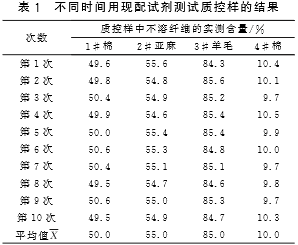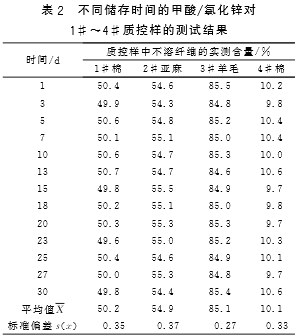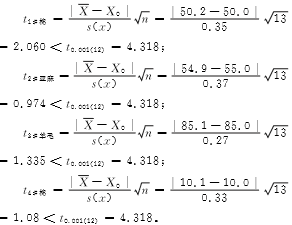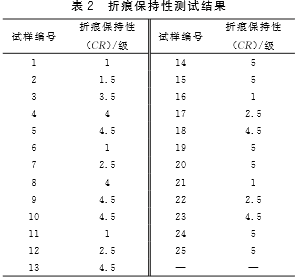Chemical reagents play a very important role in the qualitative and quantitative process of textile fiber components. There are also differences in the storage time and storage methods of reagents. The reagents used for the quantification of fiber components can be divided into ready-to-use and ready-to-store. Kind. The reagents currently used are ready to be decomposed and deteriorated, and the timeliness of testing is high. For reagents that have no clear requirements on storage time, one-time preparation can be used in multiple times, which is beneficial to the inspection personnel to operate in batches, saving labor costs and relatively high detection efficiency. However, for reagents that are not clearly stated in the shelf life, there may be a failure due to the storage time exceeding the expiration date, which may affect the detection results, such as formic acid/zinc chloride solution. Formic acid/zinc chloride solution is commonly used in the determination of fiber components for the quantitative analysis of cotton and regenerated cellulose fibers, hemp and regenerated cellulose fibers, wool and silk blended products, the amount of reagents is relatively large, but in the corresponding method standards for formic acid The storage time of the zinc chloride solution is not clearly stated. It is easy to cause the depletion of residual zinc chloride in the reagent bottle. Multiple use in one preparation is not clearly stated due to storage time. If it is stored improperly, it will easily lead to test error. There are few studies on the storage time of formic acid/zinc chloride solution in the industry, and most of them focus on the quantitative dissolution method of the reagent. In this paper, the storage time of formic acid/zinc chloride solution was studied. Four kinds of quality control samples were used to test the formic acid/zinc chloride solution reagents stored at different times to verify the storage time of formic acid/zinc chloride solution. The effect of accuracy is to investigate the reasonable storage time of formic acid/zinc chloride solution and improve the detection efficiency and accuracy.
test
1.1. Test equipment
CU-6 fiber fineness analyzer (Beijing Hezhongshi Technology Co., Ltd.), UF110 type oven (Memmert, Germany), SPH-110×12 reciprocating constant temperature oscillating water bath shaker (Shanghai Shiping Experimental Equipment Co., Ltd.), TB -214 electronic balance (Germany Sartorius, accuracy 0.1 mg), GM-1.0A diaphragm vacuum pump (Tianjin Jinteng Test Equipment Co., Ltd.), glass sand core å®¹é‡ (capacity 30 mL, micropore diameter 90 ~ 150μm) , a desiccator (with discolored silica gel), with a stoppered flask (capacity 250 mL).
1.2. Test equipment
Under the test conditions of a dissolution temperature of (70 ± 2) ° C and a dissolution time of (20 ± 1) min, one of the components was dissolved and removed from the mixture of known dry mass using a formic acid/zinc chloride solution to collect the residue. The material is washed, dried and weighed, and the mass fraction of the dry mass of the mixture is calculated by the corrected mass, and the mass fraction of each component in the mixture is obtained from the difference.
1.3. Sample sample
Prepare 4 quality control samples, labeled 1#, 2#, 3# and 4#, where 1# is 19.6 tex cotton/modal 50/50 white knit plain cloth, 2# is 29.5 tex linen/viscose 55/ 45 light gray knitted jersey, 3# for 18.4 tex wool/mulberry 85/15 light blue knit plain cloth, 4# for 19.8 tex cotton/viscose 10/90 pink knit plain cloth.
1.4. Test reagent
Formic acid/zinc chloride solution: 20 g of anhydrous zinc chloride (mass fraction > 98%) and 68 g of anhydrous formic acid plus water to 100 g. In this test, 10L formic acid/zinc chloride solution was prepared at one time, stored in a brown bottle, and sealed in a (20 ± 2) °C constant temperature and light-proof environment.
Dilute ammonia solution: Take 20 mL of ammonia (density 0.880 g/mL) and dilute to 1 L with water.
1.5. Test methods
The test conditions of dissolution temperature (70±2) °C and dissolution time (20±1) min were selected, and the sample and reagent were tested in a ratio of 1 g:100 mL. The prepared reagent is tested from the same day. The first day is equivalent to the current reagent. After each of the four days, four samples are taken for parallel test. The morphology of the insoluble fiber is observed by a microscope to determine whether it is completely dissolved. The results of each sample were averaged and 1 decimal place was reserved. According to the test results, the degree of influence of formic acid/zinc chloride on the test results was analyzed, and the reasonable storage period of formic acid/zinc chloride was calculated.
1.6. Calculation formula

In the formula: P€€€ The percentage of net dry content of insoluble fiber, %; P€€€% of dry fiber content of dissolved fiber, %; P€€€% of dry fiber content of dissolved fiber, %; m€ €€ The dry mass of the sample before dissolution treatment, g; m€€€€€€€€€€€€€€€€€€€€€€€€€€€€€€€€€,,,,,,,,,,,,,,,,,,,,,,,,,,,,,,,,,,,,
Results and discussion
2.1. Quality control sample stability test
In order to verify the stability of the quality control sample under specific laboratory test conditions, the test is carried out under the conditions of (70±2) °C and dissolution time (20±1) min, respectively. The quality control sample was tested once a day for a parallel sample test for 10 times. The results were calculated according to the formulas (1) and (2), and the average value X of the 10 tests was calculated. The test results are shown in Table 1.

It can be seen from Table 1 that under the selected test conditions, after repeated measurements, the cotton content of the 1# quality control sample ranges from 49.5% to 50.6%, and the maximum difference is 1.1%; 2# quality control sample linen The content ranged from 54.6% to 55.6%, and the maximum difference was 1.0%; the cotton content of the 3# quality control sample ranged from 84.3% to 85.6%, the maximum difference was 1.3%, and the cotton content of the 4# quality control sample ranged from 9.7. %~10.5%, the maximum difference is 0.8%. It can be seen from the test data that the formic acid/zinc chloride solution is now compatible with the current quantitative control sample data, which is stable and meets the requirements of quality control sample stability.
2.2. Accuracy test
The chemical reagents used in the preparation and storage of the fiber component laboratory are generally suitable for one month, and it is recommended to adjust the reagent configuration amount in time for more than one month. This test is to configure 10L formic acid/zinc chloride solution once. Because zinc chloride is difficult to dissolve in formic acid at room temperature, it is recommended to put the reagent in a water bath to heat it, stir it to accelerate dissolution, and prevent the reagent from volatilizing and affect the solution concentration. Store the prepared reagent in a brown volumetric flask and store it in a (20 ± 2) °C constant temperature and light-proof environment. According to the test conditions in the test method, the first parallel sample test is carried out on each of the four quality control samples, and the test is repeated every few days according to the same test conditions, and the results are calculated according to formula (1) and formula (2), if the parallel sample test If the value difference exceeds 1.0%, it will be marked with ※; otherwise, the average value of the parallel test results will be taken, and the test results will be analyzed to calculate the average value X and standard deviation s(x) of the four quality control samples, and test The results were tested using the t-distribution to determine the difference between the test value and the expected value. The test results are shown in Table 2.

It can be seen from the test data in Table 2 that the results of different storage time tests have small fluctuations, but they are all within the standard tolerance of the method. The content of 1# quality control sample cotton fiber ranged from 49.6% to 50.7%, and the maximum difference was 1.1%; the content of 2# quality control sample flax test ranged from 54.3% to 55.5%, the maximum difference was 1.2%; 3# The quality control wool test content ranged from 84.6% to 85.5%, the maximum difference was 0.9%, and the 4# quality control sample cotton fiber test content ranged from 9.7% to 10.6% with a maximum difference of 0.9%.
In order to determine the difference between the test value and the true value, the test data is tested by the t-distribution, and the t-distribution table is known to be €€€€€€€€€€4.318, calculated:

According to the t distribution, it can be determined that there is no significant difference between the test values ​​of the four quality control samples and the actual values. That is, the formic acid/zinc chloride solution was stored within 30 days, and had no significant effect on the accuracy of the fiber content quantitative test. The test data completely met the standard requirements.
Results and discussion
Since SMF acts as a core wire in the core spun yarn, SMF/cotton woven fabric can retain the advantages of pure cotton fabric, good moisture absorption, low pilling, and comfortable wearing. The effects of the stamping process on the shape memory properties of SMF/cotton woven fabrics and other related properties are discussed below.
3.1. Effect of pressing and setting process on crease retention
Table 2 shows the results of the crease retention test of the SMF/cotton woven fabric subjected to press setting after washing and drying.
It can be seen from Table 1 and Table 2 that the crease retention performance (CR value) of the SMF/cotton woven fabric increases as the pressing time is constant. However, no matter which pressing time, the CR value of the fabric is not reached at the highest value (5 grades) when the pressing temperature is equal to TS (185 ° C), but is reached up to 190 ° C; in addition, the pressing temperature is low. When the TS has a certain extent (180 ° C), the CR value of the fabric has increased to varying degrees, and the increase rate depends on the pressing time. The longer the pressing time, the greater the increase. It is considered that the TS value of the polyurethane shape memory material actually appears as a temperature range. When the pressing temperature is lower than the nominal TS, the crease retention performance of the fabric tends to rise, and only when the external action temperature is higher than When the nominal TS is a certain extent, the crease retention performance of the fabric is at an ideal level.

As the experimental results show that only when the pressing temperature ≥ 190 ° C, and the pressing time ≥ 50 s, the crease retention of the fabric can reach 5, so for the SMF / cotton woven fabric press setting, the best process should Set to: pressing temperature 190 ° C, pressing time 50s. If the pressing temperature is lower than 190 ° C, or the pressing time is less than 50 s, the crease retention performance of the fabric will not reach the ideal level; but when the pressing temperature is too high or the pressing time is too long, the mechanics of the fabric on the one hand Performance is affected, and on the other hand, unnecessary processing costs are added.
3.2. Analysis of fabric deformation rate and shape recovery rate
The deformation rate and shape recovery rate of six fabric samples (14#, 15#, 19#, 20#, 24#, 25#) with crease retention of 5 grades and control samples before and after compression setting were tested. Table 3 shows the test results.
It can be seen from Table 3 that on the one hand, in a total of 48 index values ​​of deformation rate and shape recovery rate (excluding the index value of the control sample), 45 values ​​(accounting for 93.75% of the total number) reached 80% or more, indicating that SMF was added. After the cotton fabric has good crease retention performance, it also has a high deformation fixation rate and shape recovery rate. In comparison, the index value of the control sample (cotton fabric) is only 39.4% to 61.3%. On the other hand, the experimental results show that the index values ​​of deformation rate and shape recovery rate before and after pressing stereotypes show no significant downward trend, indicating that the pressing process selected in the study did not cause damage to the polyurethane material.

3.3. Fabric related performance analysis
Similarly, six related fabric samples (14#, 15#, 19#, 20#, 24#, 25#) and the control samples with crease retention of 5 grades were tested for other related properties, including shrinkage and flatness. The test results are shown in Table 4.
It can be seen from Table 4 that the shrinkage rate of all the samples did not exceed 3.5%, and the average of the warp shrinkage rate was 3.1%, and the average value of the latitudinal shrinkage rate was 2.8%, which was less than 4.1% and 3.3% of the control, respectively. . The reason is analyzed. On the one hand, the cotton fiber content in the core yarn is only 83% (the rest is SMF), so that the yarn diameter is increased due to the swelling of the cotton fiber, so that the shrinkage rate of the fabric is increased to a lesser extent than the pure cotton fabric; On the other hand, the core-spun yarn twist coefficient is 15% higher than that of the pure cotton yarn , and the cotton fiber is swollen to stimulate the yarn to be retracted, so that the fabric shrinkage rate is increased to a greater extent than that of the pure cotton fabric; in addition, the shape memory property is obtained. The SMF core wire can produce a "skeleton effect" which can hinder the yarn from shrinking in the longitudinal direction to some extent (the yarn cannot be freely untwisted due to the interlacing of the warp and weft in the fabric, resulting in a shortened length). The analysis considers that the above three effects are superimposed, so that the shrinkage rate of the SMF/cotton woven fabric is smaller than that of the pure cotton woven fabric. In addition, the flatness of all the samples reached more than grade 4, which was superior to ordinary cotton fabrics to a large extent (Table 4 shows that the flatness of the control samples is only 2.5 grades). According to the analysis, the mechanism is that the SMF of the sample is creased and pressed, and the SMF of the rest of the sample is flattened and pressed, so that the fabric has good flatness. The above results show that the SMF/cotton woven fabric after finishing by pressing and setting has excellent shape memory performance, and its dimensional stability and fabric flatness are at a good level.

in conclusion
a) Formic acid/zinc chloride solution prepared according to the specified method, stored in a cool (20±2) °C temperature-protected environment for 30 days, at (70±2) °C, and the dissolution time is (20±1) min. Next, quantitative test cotton / modal, linen / viscose, wool / silk, cotton / viscose four kinds of blended fabric, there is no significant difference between the test value and the actual value, that is, the two reagent preparation methods have no significant effect on the test results .
b) Preparation and storage of formic acid/zinc chloride solution Pay attention to the standard operation. Multiple use in one preparation can prevent the depletion of residual zinc chloride in the reagent bottle due to multiple preparation of reagents, and improve the accuracy of reagent preparation.
c) Whether the formic acid/zinc chloride solution has been stored for more than 30 days or stored by other methods remains to be effective and needs further study.
Men's Optical Glasses are carefully designed to wear fashion according to men's quality of life. Nowadays, the fashion elements are integrated into the design. The men's different faces design different frame shapes. Each frame shows the different charm of the personality, and it can show the taste more. When you work, you can choose pure titanium metal glasses, which are both relaxing and intelligent. When you are at home or traveling, you can choose leisure styles and release your characteristics.
Men Optical Frames,Mens Gold Eyeglass Frames,Mens Fashion Eyeglasses,Men'S Wire Frame Glasses
China Guangdong Shenzhen city Omelle glasses Co., Ltd. , https://www.omellelenses.com